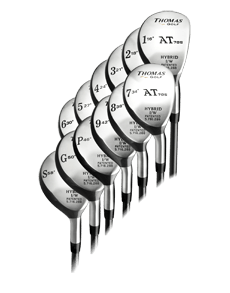
Coordinating your left arm and shoulder during the backswing is crucial for generating power, maintaining control, and achieving proper swing mechanics in golf. Here are some techniques to help you coordinate these movements effectively:
- One-Piece Connection: Aim to achieve a connected and synchronized movement between your left arm and shoulder during the backswing. As you start your backswing, focus on initiating the rotation of your left shoulder while keeping your left arm connected to your chest. This connected motion promotes a more efficient coil and helps maintain control throughout the swing.
- Extension and Width: To maximize power and maintain a wide swing arc, focus on extending your left arm fully during the backswing. As your left shoulder turns, allow your left arm to naturally extend away from your body, creating width in your swing. This extension helps create leverage and generates more potential energy to be transferred into the downswing.
- Shoulder Turn: Your left shoulder plays a pivotal role in the backswing. Focus on turning your left shoulder away from the target as you initiate the backswing. This turning motion helps create torque and coil in your upper body, setting up the potential for a powerful downswing.
- Avoid Over-Rotation: While it's important to turn your left shoulder, be mindful of over-rotation. Excessive rotation can lead to poor swing mechanics and loss of control. Aim for a comfortable range of motion that allows you to maintain balance and control throughout the swing.
- Maintain Relaxed Tension: It's important to find a balance between maintaining tension in your left arm and shoulder and avoiding excessive tightness. Keep your left arm and shoulder relaxed to allow for a fluid and natural movement during the backswing. Maintaining relaxed tension helps promote a smooth transition into the downswing.
- Practice Drills: Incorporate drills that specifically focus on coordinating your left arm and shoulder during the backswing. For example, you can practice swinging with a towel tucked under your left arm, which encourages the connection between your left arm and torso. Another drill is to place a golf glove under your left arm and maintain its position throughout the backswing, ensuring proper synchronization.
Remember, every golfer may have slight variations in their backswing technique based on individual physical characteristics and swing styles. It's important to work with a golf instructor or coach who can provide personalized guidance and help you refine your specific backswing movements.
Regular practice and awareness of your left arm and shoulder coordination will help you develop a more consistent and powerful swing. Stay patient, stay committed to proper technique, and continue to refine your backswing through focused practice sessions.
- Pay attention as your round goes on. The timing of your backswing is something that can start off on the right foot early in a round – only to go south as the day wears on. You might get frustrated with your play and start to rush your swing, or you may get nervous and slow down as you tighten up.
- Everyone responds in their own way to the pressure they feel on the course, so it’s impossible to say exactly what will happen to your swing. What we can say, however, is that you need to pay attention to any changes so you can respond accordingly. If you feel yourself rushing, for instance, make it a point to slow down and get back to your rhythm.
- Take your time going back. If you are going to use a connected backswing successfully, you are going to need to give yourself time to make it all the way through the turn away from the ball. This is a point where many golfers fall into the trap of rushing the action.
- In a hurry to get the shot over with, many players will force the backswing to finish as soon as possible. Don’t put yourself in that category. There is no reason to rush, so take your time and get all the way to the top of the swing with everything properly connected.
- Keep your chin up. This is something of a ‘hidden’ swing tip, but it is an important one to keep in mind nonetheless. In order to turn your shoulders away from the target properly, you are going to need to keep your chin up and away from your chest.
- If you keep your chin down too far, your shoulder will run into it on the way back and your turn will be cut short. You can still keep your eyes down on the ball, but you need to have your chin up high enough to allow your shoulder to pass underneath cleanly.
The coordination of all of the various parts of your swing is one of the biggest challenges in golf. When done right, it looks easy – the swing simply moves back and through, and the ball is sent on its way. Despite this simple appearance, getting yourself to that point is no easy feat. We hope that the tips offered in this article will take you a step closer to successfully using your left arm and shoulder in tandem to guide the golf swing.
Update:
Backswing Techniques: Coordinating Your Left Arm and Shoulder
- Left Arm Extension:
- Keep your left arm extended as you start the backswing. Avoid excessive bending at the elbow in the initial phase.
- One-Piece Takeaway:
- Initiate the backswing by moving your left arm, hands, and shoulders as a single unit. This promotes a synchronized and connected motion.
- Rotational Movement:
- Allow your left shoulder to turn smoothly, initiating a rotation. The left arm should follow the turn of the shoulders, maintaining a natural connection.
- Maintain Width:
- Keep your left arm relatively straight to maintain width in the backswing. This width contributes to power and a more controlled downswing.
- Left Arm Across the Chest:
- As the backswing progresses, let your left arm swing across your chest. This natural movement helps with a full turn and sets the stage for a powerful downswing.
- Avoid Overrotation:
- While turning your left shoulder, avoid over-rotating or overswinging. Maintain control and balance to set up a well-controlled downswing.
- Wrist Hinge:
- Allow for a natural wrist hinge as the club moves farther back. This hinge occurs in conjunction with the shoulder turn, contributing to increased clubhead speed.
- Weight Transfer:
- Coordinate your left arm movement with a subtle weight transfer to the right side. This helps load the back leg, setting the stage for an effective downswing.
- Pause at the Top:
- Consider a brief pause at the top of the backswing to ensure a complete turn and proper positioning before transitioning into the downswing.
- Consistent Tempo:
- Maintain a consistent tempo throughout the backswing, avoiding abrupt movements. A smooth and controlled backswing often leads to better ball-striking.
Q&A on Backswing Techniques: Coordinating Your Left Arm and Shoulder
- Q: Should my left arm be perfectly straight in the backswing?
- A: While a slight bend is acceptable, maintaining a relatively straight left arm helps create width and promotes a more powerful downswing.
- Q: How can I prevent overswinging with my left arm and shoulder?
- A: Focus on maintaining control and balance. Avoid excessive shoulder turn, and ensure that your backswing is within a comfortable and controlled range.
- Q: Is it necessary to hinge my wrists during the backswing?
- A: Yes, a natural wrist hinge is beneficial. It helps store energy for the downswing and contributes to increased clubhead speed.
- Q: Should the left shoulder move downward during the backswing?
- A: The left shoulder should rotate and tilt slightly downward as part of a natural backswing motion. This helps create the desired angle for a powerful downswing.
- Q: How does the coordination of the left arm and shoulder impact accuracy?
- A: Proper coordination contributes to a more consistent and accurate swing. It helps square the clubface at impact and promotes a more controlled ball flight.
- Q: Can I still achieve power with a controlled backswing?
- A: Yes, power comes from a combination of factors, including a well-coordinated backswing and an effective weight transfer. A controlled backswing can lead to a powerful downswing.
- Q: Are there drills to improve the coordination of the left arm and shoulder?
- A: Yes, drills such as the “One-Piece Takeaway” drill or focusing on a synchronized turn in front of a mirror can help improve coordination.
- Q: How does the left arm position affect the angle of attack?
- A: A well-positioned left arm helps set the angle of attack. Maintaining a straight or slightly bent left arm contributes to a consistent and effective angle of attack.
- Q: What role does the left arm play in creating lag in the downswing?
- A: The left arm, along with the wrists, plays a role in creating lag. Proper coordination in the backswing allows for a more efficient release of lag during the downswing.
- Q: Can I practice backswing coordination at home?
- A: Yes, you can practice backswing coordination without hitting balls. Focus on mirror work, slow-motion swings, and drills to develop a smooth and connected motion.
Remember that individual differences in body mechanics may influence the specifics of your backswing. It's advisable to work with a golf instructor for personalized guidance and feedback tailored to your unique swing characteristics.






